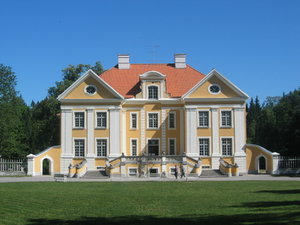Advertisement
Published: January 25th 2009

 PALMSE MANOR
PALMSE MANOR
Begun 17th Centuary(Excerpted from my book Our Summer in Estonia available at Amazon.com)
Mid-week and mid-summer, a perfect time, with few tourists around and most people at work, to leave Tallinn for a day in the country. We decided on a day trip to Lahemma National Park and Land of Bays, which lies about 70 miles (100km) east of Tallinn and halfway to Narva, a major Estonian city that borders Russia. The park spreads about 40 miles along the northern coast and was designated a national park in 1971. It remains mostly unspoiled , very forested, with a few small villages and the site of some of the most extraordinary manor houses/estates from the bygone era when the Baltic-German barons were the landed gentry.
The main reason the park even today is so well-preserved and in a state of nature is due to the Soviet system's paranoia should anyone escape their "workers Paradise." Very few Estonians and no foreigners were allowed near the coast, for fear they might have been tempted to make a break for it and swim the 50 miles across the open sea to Finland! While on the subject of Soviet madness, I might as well mention at this point, that the former fishing villages along the coast remain depopulated, and the fishing industry disappeared during Soviet occupation out of concern for border security.
Thus, mid-week, late-July we set out with a light breeze and mild temperatures for an almost traffic less one hour drive to Palmse Manor. But before introducing Palmse Manor, I need to explain a little about the Baltic Germans for those who are unfamiliar with Estonian history. Without going back too far, suffice to say, that during the 15th and 16th centuries, and the rule of the Livonian order, Estonia became widely populated with landed barons, mostly of Germanic origin. These Baltic Germans pretty much ruled the land, even during later centuries when Sweden and Russia ruled the country. The barons were talented, good administrators, kept order, sent their sons to Stockholm or St. Petersburg for education as the case may be, were industrious farmers and businessman, served the King or Tsar in many capacities, and "captained" their armed forces. By the mid-nineteenth century there were 1000 such manor house estates in Estonia. Considering that a medium sized estate would have about 750 peasants working the land, and perhaps another 100 artisans and servants engaged in Manor industries and household services, it is easy to see the importance of this system, which engaged a third or more of Estonia's population.
Palmse Manor, our destination, tells the tale of this unique centuries-long period of Estonian history, reminding us of the servitude it represents, and keeping in mind that this was one, although a large one, of over a thousand such enterprises
Advertisement
Tot: 0.369s; Tpl: 0.017s; cc: 9; qc: 45; dbt: 0.0677s; 1; m:domysql w:travelblog (10.17.0.13); sld: 1;
; mem: 1.1mb

 PALMSE MANOR
PALMSE MANOR